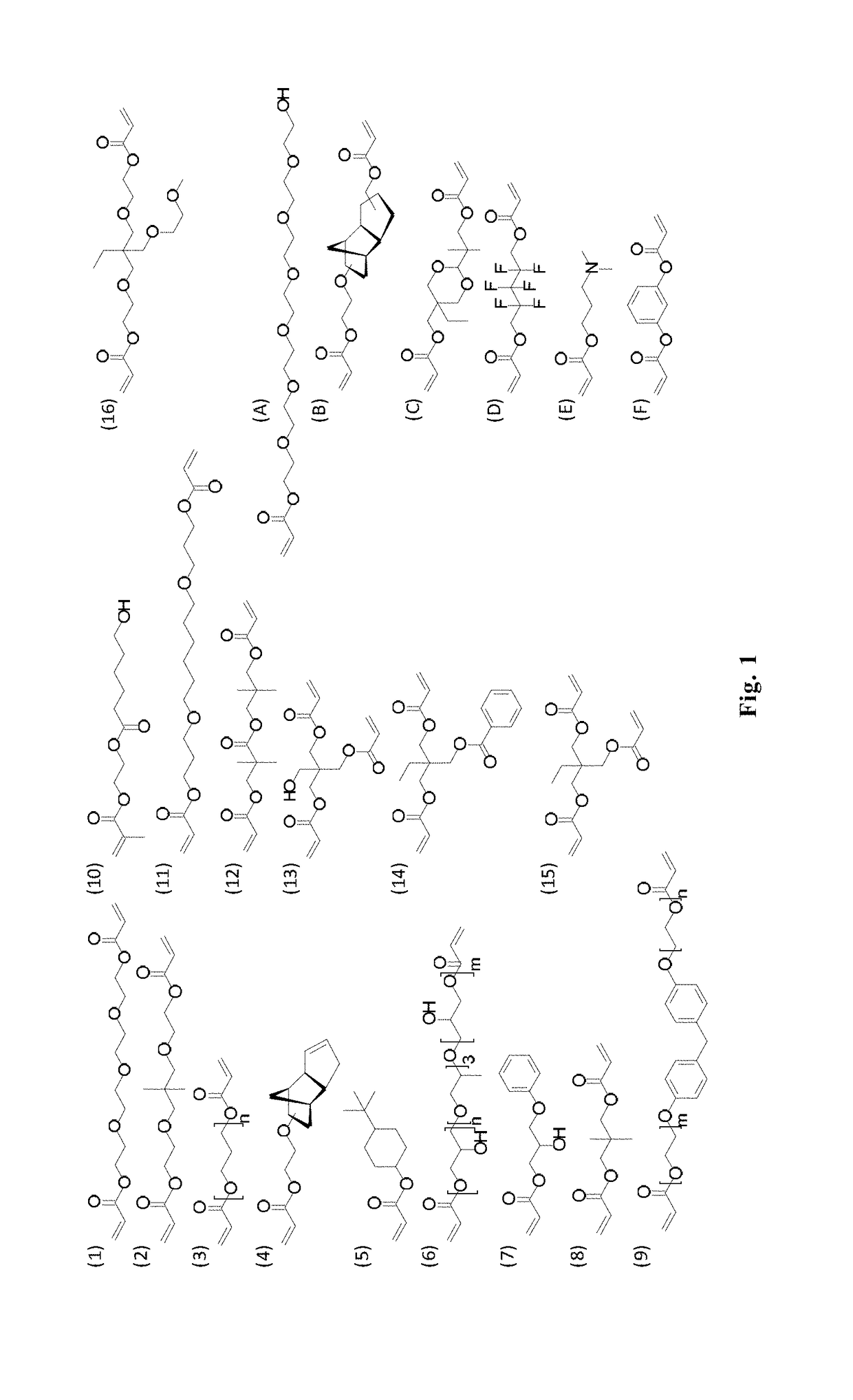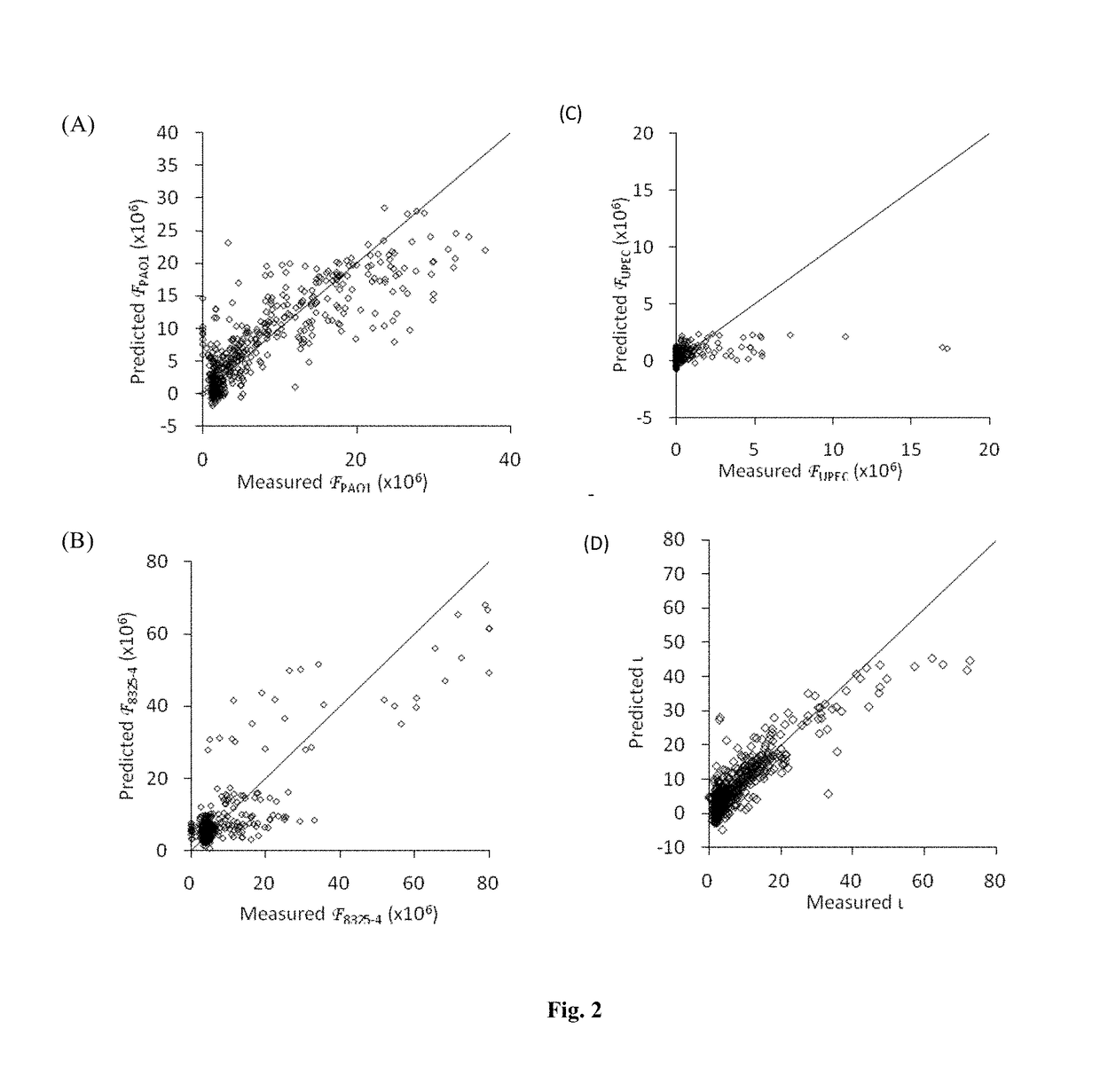Polymers which resist bacterial attachment
a technology of bacterial attachment and polymer, which is applied in the field of polymers which resist bacterial attachment, can solve the problems of difficult control of the release rate and maintain a constant level of concentration at the surface, and the bacterial infection is becoming one of the most common and serious complications, and achieves the effect of preventing biofilm formation and great efficacy in preventing biofilm formation
- Summary
- Abstract
- Description
- Claims
- Application Information
AI Technical Summary
Benefits of technology
Problems solved by technology
Method used
Image
Examples
example 1
Summary
[0197]Sixteen monomers (monomers 1-16 as shown in FIG. 1), were mixed as the major component with another six monomers (monomers A-F as shown in FIG. 1) at ratios of 100:0, 90:10, 85:15, 80:20, 75:25 and 70:30 to create 496 unique monomer solutions. This provided a material library for micro array covering a large combinatorial space. These solutions were printed in triplicate as 300 μm diameter spots onto a poly(hydroxyl ethylmethacrylate) (pHEMA) coated microscope slide and photopolymerised.
[0198]To develop a high throughput bacterial adherence assay, three pathogens PA01, 8325-4 and UPEC were transformed with plasmids with a green fluorescent protein (GFP) gene, and subsequently incubated with the polymer microarray for 72 hours. The attachment was quantified to determine the fluorescence signal () from each strain using a high throughput fluorescence approach. The value of from each strain on each material composition was normalised to the maximum intensity on each slide...
example 2
Summary
[0237]A first generation array of 116 acrylate and methacrylate homopolymers was screened for antibacterial properties. From this array 18 monomers were selected that produced homopolymers that had less bacterial attachment that the pHEMA background. These monomers were mixed together pairwise to produce a second generation array of 324 copolymers that were screened for antibacterial properties.
Methods
Monomers
[0238]Initially an array of 116 acrylate and methacrylate homopolymers was screened for antibacterial properties. The 116 homopolymers was produced from monomers commercially available from Sigma that were amenable to the polymer microarray format.
[0239]A range of responses to bacteria were observed ranging from low to high bacteria adherence. From this array 18 monomers were selected that produced homopolymers that had less bacterial attachment that the pHEMA background.
Substrate Formation
[0240]Epoxy coated glass slides (Genetix) were dip-coated with a pHEMA solution. T...
example 3
[0255]To further investigate the role of amphiphilic materials for preventing bacterial attachment, a microarray was produced that contained homopolymers of 15 (meth) acrylate monomers that had aliphatic, cyclic or aromatic pendant groups. The monomers are shown in FIG. 10.
[0256]The biological performance of test materials consisting of homopolymers formed from aliphatic, cyclic and aromatic acrylate and methacrylate monomers was tested in a polymer microarray format. The fluorescence intensity F was measured after 72 h incubation with P. aeruginosa (PA), S. aureus (SA) and UPEC in RPMI-1640. The bacterial performance (τ) values were also calculated.
[0257]The fluorescence intensity (F) from GFP P. aeruginosa, S. aureus and UPEC for each material, and the composite bacterial performance assessment (i) of these three intensities, is shown in FIG. 11. The calculated i value is also shown (¢). The chemical structure of the monomer used is shown under the corresponding F and i value and ...
PUM
| Property | Measurement | Unit |
|---|---|---|
| wt % | aaaaa | aaaaa |
| wt % | aaaaa | aaaaa |
| wt % | aaaaa | aaaaa |
Abstract
Description
Claims
Application Information
 Login to View More
Login to View More - R&D
- Intellectual Property
- Life Sciences
- Materials
- Tech Scout
- Unparalleled Data Quality
- Higher Quality Content
- 60% Fewer Hallucinations
Browse by: Latest US Patents, China's latest patents, Technical Efficacy Thesaurus, Application Domain, Technology Topic, Popular Technical Reports.
© 2025 PatSnap. All rights reserved.Legal|Privacy policy|Modern Slavery Act Transparency Statement|Sitemap|About US| Contact US: help@patsnap.com



